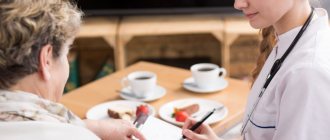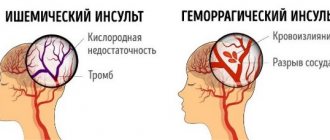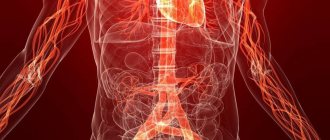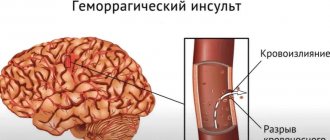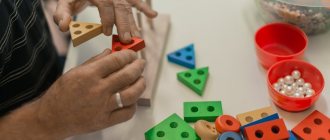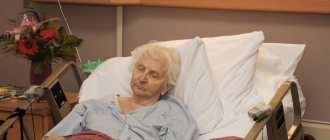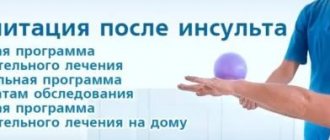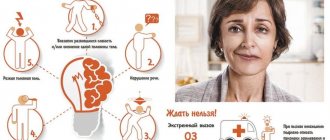Various speech dysfunctions are a common symptom and complication of stroke. They are classified as focal manifestations of certain areas of the brain. Restoring speech after a stroke must be included in a comprehensive program of rehabilitation measures for a particular patient.
The task of returning a person to an active life is carried out by various specialists: neurologists, neurosurgeons, rehabilitation specialists, therapists. It is good if the medical institution has a speech therapist. Then classes on speech development can begin from the first weeks of illness when the general condition has stabilized.
Why does a person lose the ability to speak?
Loss of the ability to speak (aphasia) due to hemorrhagic or ischemic stroke is associated with damage to the speech center in the cerebral cortex. In right-handed people it is located in the left hemisphere. However, there are types of pathology that simultaneously affect the cerebellum, parietal and frontal lobes.
We should not forget that a person who has suffered a stroke not only cannot speak, but also has difficulty understanding speech addressed to him, and loses the ability to read and write. This is typical for the location of the ischemic focus in the temporal region (sensory aphasia).
When the inferior frontal and parietal areas are damaged, motor aphasia develops. It is characterized by a mismatch of speech motor commands of the brain. The person understands everything, but remains silent or speaks in monosyllables. Long phrases are too much for him. This type of speech impairment is recovered much worse than sensory impairment.
Typical speech centers in humans
Damage to the cerebellar structures is characterized by flaccid or spastic paralysis of the entire speech apparatus (tongue, lips, larynx, pharynx). The voice becomes dull, the patient cannot pronounce consonants correctly and speaks very slowly.
How to restore the ability to speak in an adult after losing it?
How long it takes for speech function to recover depends on how severely the brain was damaged.
Therefore, in some patients, the ability to speak is restored quite quickly (within a few weeks or months), while in others it takes years, and it is difficult to predict how long it will take. To restore patients who have suffered a stroke, the following types of rehabilitation are used:
- Drug therapy.
- Classes with a speech therapist.
- Physiotherapy.
- Massage.
- Surgical intervention.
Medicines
During rehabilitation after a stroke, the doctor prescribes several groups of drugs to the patient that help reduce side effects, improve the condition and help the patient quickly return to their normal lifestyle:
- Muscle relaxants.
- Antidepressants.
- Anticonvulsants.
- Antiplatelet agents.
Muscle relaxants
On a note. In the third month after a stroke, the patient may develop muscle hypertonicity, which greatly slows down the rehabilitation process.
Then muscle relaxants are prescribed that can reduce excessive muscle tone. The best muscle relaxants for stroke:
- Sirdalud (cost in Moscow from 227, in St. Petersburg from 176).
- Tizalud (cost in Moscow from 160, in St. Petersburg from 125 rubles).
Antidepressant series drugs
Almost 80% of patients suffer from depression after a stroke, which slows down the recovery process. In this case, antidepressants are prescribed. The best antidepressants for stroke:
- Nortriptyline (cost in Moscow from 990, in St. Petersburg from 1,000 rubles).
- Paxil (cost in Moscow from 650, in St. Petersburg from 660 rubles).
Anticonvulsants
When seizures occur, anticonvulsants are prescribed, but they should be taken with caution, as this group of drugs can cause side effects. The best anticonvulsants for stroke:
- Finlepsin (cost in Moscow from 215, in St. Petersburg from 193 rubles).
- Convulex (cost in Moscow from 116, in St. Petersburg from 135 rubles).
Antiplatelet agents
If after a stroke the patient’s blood becomes more viscous, this slows down the recovery of brain tissue. In this case, the help of antiplatelet agents is required to prevent the formation of blood clots. The best antiplatelet drugs for stroke:
- Reopoliglyukin (cost in Moscow from 102, in St. Petersburg from 110 rubles).
- Clopidogrel (cost in Moscow from 226, in St. Petersburg from 205 rubles).
Important! Any medications should be prescribed only by the attending physician. Do not self-prescribe medications, otherwise this can only worsen the patient’s condition.
Medication alone does not provide much benefit, but it does help progress recovery when used with other types of therapy, such as speech therapy and physical therapy.
- How exactly does speech restoration proceed after a stroke?
Classes with a speech therapist
At the first lesson, the speech therapist draws up a plan for each patient individually. The following exercises are required:
- Reading tongue twisters.
- Drawing.
- Mimic and speech therapy massage.
If all the specialist’s recommendations are carefully followed, about 20-30% of patients with moderate and severe speech disorders begin to speak normally by the time they are discharged from the hospital. Classes can also be held at home. The exercise program must be combined with medications, physical therapy and other types of rehabilitation.
Physiotherapy
This type of rehabilitation stimulates muscle recovery and helps to achieve better results from classes with a speech therapist and from taking medications.
- Magnetotherapy. This procedure stimulates all processes in the brain, and also improves the functioning of the endocrine and nervous systems. A rather painful method, but it is considered one of the most effective. The patient's condition improves after 2-3 weeks.
- Dorsanval. Prescribed for poor blood supply to the brain and limbs. After a whole course of procedures, which is at least 5-7 sessions that take place over 2-3 weeks, the patient’s condition improves significantly.
Massage
Therapeutic massage for stroke significantly improves blood supply to the affected tissues, which increases the flow of oxygen and other nutrients to them. In addition, massage helps relieve muscle and psychological tension. A therapeutic massage course usually consists of 10 sessions , but can be adjusted individually for each patient.
Note! A massage course can only be conducted by a qualified specialist with a medical education.
Surgery
A method such as surgery is resorted to in extreme cases, when other methods do not improve the patient’s condition and cannot restore lost speech. To restore speech, a neurosurgical operation is performed, which creates additional connections between healthy tissues and vessels in the speech area of the brain, without affecting the damaged areas.
Other speech disorders
Speech does not necessarily disappear as a result of a stroke. Ischemic damage can also cause other disorders: a person becomes very verbose. At the same time, he does not completely control his words. Replaces one with another, guided not by meaning, but by similar combinations of sounds.
Another option is the lack of ability to remember the names of objects, phenomena, actions, names. The patient speaks without nouns. He is difficult to understand.
In order to learn how to restore speech after a stroke, you need the participation of experienced specialists, the persistence of the patient and the patience of relatives.
Speech therapy exercises to restore speech after a stroke at home
Let us now consider what methods a specialist can offer to restore a patient’s speech, and how they should be applied.
Articulation and breathing exercises
First, the person is asked to simply breathe, then, as he exhales, pronounce certain consonant sounds, one sound per exhalation. After this, while exhaling, all these sounds are pronounced in a row. There are no more than four of them. Sounds can be pronounced while exhaling, also with the chin raised.
Articulation gymnastics after a stroke
It includes exercises for the tongue, lips, voice, and facial muscles.
Exercises for the tongue and soft palate
- Stick your tongue out of your mouth and hold it there for a few seconds.
- Pull it down again and bend it up, hold it for a while.
- Pull it down and direct it first to the right corner of the mouth, then to the left.
- Move the tip of your tongue back and forth across the roof of your mouth.
- Direct your tongue to the right and left cheek.
- Click your tongue, first once, then twice, then three.
- Relax your tongue and, moving it back and forth, lightly bite with your teeth.
- Lick your lips first in one direction, then in the other.
Lip exercises
- Move your lips forward.
- Make a smile with your mouth closed.
- Bare your teeth and raise your upper lip, hold this for a couple of seconds.
- Puff out your cheeks and pump the air from side to side, rolling the air around your mouth.
- Relax your lips and blow through the gap in them.
Voice exercises
Speech gymnastics is performed for ischemic or hemorrhagic stroke.
- We pronounce all the vowel sounds separately, first long, then short, while exhaling. After this, as you exhale, we pronounce all the sounds in a row.
- We say the sound Y only articulatory, without sound, and feel the tension under the chin.
- We pronounce all the vowel sounds in a row, flowing into one another, alternately emphasizing different sounds.
- We pronounce consonant sounds, first unvoiced, separately, then one after another on one exhalation. After this, we pronounce voiced sounds in the same way. We add consonant sounds with vowels into certain syllables, while alternating paired unvoiced and voiced consonants.
All combinations of sounds, their permutations and combinations are determined by the speech therapist.
Tongue twister exercises after a stroke
First, we ask the patient to finish the tongue twister he knows, gradually increasing the number of words he says. If possible, we bring the exercise to perfection.
Exercises for facial muscles
- Raise your eyebrows, lower them, frown, relax.
- Open your mouth wide, try to stretch it, then relax it.
- Smile without opening your mouth.
- Inflate and deflate your cheeks.
- Pull your lips out as if for a kiss.
- Extend your tongue as far as possible in different directions from your mouth.
- Move your lower jaw carefully, first to the left, then to the right, then in a circle.
Speech therapy massage after stroke
After completing a set of exercises, it is necessary to apply a facial massage to each area of the face.
It is important that massage movements are selected only by a specialist. Some areas of the face will need to be relaxed, while others will need to be toned. If you approach this on your own, you can cause irreparable harm.
In addition to massaging the facial muscles directly, they massage the tongue, lips, inner surface of the cheeks, ears, scalp, and hands. All this relieves muscle stiffness and thus liberates speech.
Speech Pathologist Tips and Tricks
Dealing with an emotionally depressed patient is very difficult. Imagine a situation where a person regains consciousness, but he realizes with horror that he is unable to say anything and cannot communicate with others. In this case, “faster” does not mean “better.” The patient should feel the unobtrusive attention of others.
Some tips for relatives:
- Do not treat the patient as an inferior person doomed to disability. Talk to him calmly and carefully. Try to set yourself up for recovery. Pay attention to the smallest positive changes.
- Do not allow indifferent people to approach him. All emotions should be good.
- Play soft music, the patient's favorite radio station.
- Try to interest the patient in a dialogue with you, emphasize the importance of his opinion.
- The hearing load at the patient's location must be controlled. Radio and TV should not be played for long periods of time or loudly. Excessive noise is annoying and tiring.
Prevention of recurrent stroke
To prevent stroke and re-stroke, the following prevention recommendations should be followed:
- Pay attention to blood pressure; high levels often cause cerebral hemorrhage.
- If you suffer from hypertension, consult your doctor and choose the appropriate medication. For a better effect of normalizing blood pressure, you can combine taking pills with moderate exercise.
- Spend more time outdoors, walk more often slowly.
- Give up bad habits, they are the main cause of an attack.
- Watch your weight. Excess weight increases the risk of stroke.
- Try to find positive moments, reasons to laugh, be happy, and do what you love.
Methods of speech therapist work
The most successful results in speech restoration are possible with long-term work with a specialist.
- The speech therapist begins getting to know the patient by checking his reaction to a quiet voice or whisper.
- The tasks become more difficult gradually.
- The specialist does not work on the pronunciation of individual words or sounds; it is important for the patient to feel them in context and to learn the general meaning.
- Topics for exercises are selected from problems that are significant to the patient.
- The speech therapist begins the phrase, and the patient is asked to finish it.
- Some people respond very well to their favorite song and start singing along. The words are pronounced unclearly at first, but the situation pleases the patient.
- If the condition allows you to draw, then the doctor shows pictures on the topic and asks you to draw them.
The doctor names the depicted objects in words, the patient remembers their meaning and tries to pronounce
Initial sessions last 15 minutes. The intervals between sessions are determined by the patient's condition. After one and a half to two months they last up to half an hour.
At home, you can work with the patient only after periodic examinations by a speech therapist. Consultation with a specialist helps you choose a task and convenient exercises.
Please note that disappointment and impatience are “written” on the facial expressions of relatives. Therefore, some experts generally do not recommend exercising in the presence of loved ones.
Right side massage
Recovery after a stroke with paralysis of the right side with the help of massage begins on the 20th day of illness. This is an average date; the severity of the patient’s condition, age, concomitant diseases, etc. are taken into account.
The first massage sessions begin with gentle stroking of the limbs, back and neck muscles. The intensity of the effect increases from session to session, the massage therapist’s actions are aimed at restoring normal blood circulation and sensitivity in the affected part of the body.
Complications
Neurologists have to deal with numerous complications of the physical and psychological state of a stroke, which include:
- Gross disturbances of mental, cognitive, speech activity;
- Perceptual inhibition;
- Inflammatory phenomena of the bronchopulmonary, genitourinary system due to congestion in an immobilized patient;
- Depressive states with suicidal statements.
These manifestations require the closest attention and active therapy from specialists in various fields.
The Yusupov Hospital has a full range of rehabilitation equipment, including innovative ones, and a staff of highly qualified specialists who are proficient in modern techniques and types of massage and physical therapy. Their efforts, led by the country's best neurologists, are helping people recover from stroke paralysis.

